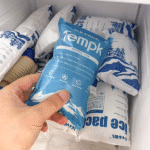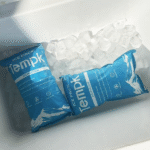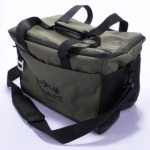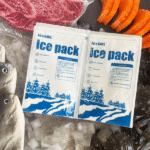Ao enviar produtos perecíveis, manter uma temperatura estável é fundamental para garantir a integridade do produto. Pacotes de gelo seco, feito de dióxido de carbono sólido (Co₂), oferecem uma solução poderosa para manter itens congelados durante o transporte. À medida que o setor de logística da cadeia de frio evolui 2025, entender as regulamentações mais recentes, melhores práticas, e tendências inovadoras no uso de gelo seco para transporte marítimo são cruciais para conformidade e segurança.
O que são Pacotes de gelo seco para envio?
Bolsas de gelo seco são folhas, blocos, ou pellets de CO₂ sólido, projetado para manter produtos sensíveis à temperatura em temperaturas ultrabaixas. Ao contrário do gelo convencional, o gelo seco sublima diretamente em gás sem deixar nenhum resíduo líquido. Esse recurso o torna ideal para enviar itens que requerem congelamento, como produtos farmacêuticos, amostras biológicas, e certos alimentos perecíveis.
Por que usar gelo seco para remessa?
As bolsas de gelo seco são uma excelente escolha para envio devido às suas propriedades únicas, fornecendo diversas vantagens sobre os métodos tradicionais de resfriamento.
-
Poder de resfriamento duradouro: O gelo seco sublima a uma taxa muito mais lenta do que o gelo normal, garantindo que suas mercadorias permaneçam frias por períodos mais longos.
-
Sem escoamento de umidade: Como o gelo seco não derrete na água, não há risco de danos causados pela água em itens sensíveis.
-
Ideal para trânsito prolongado: Para remessas que duravam mais do que 48 horas, o gelo seco costuma ser a escolha preferida para manter produtos congelados.
2025 Regulamentos para envio de gelo seco
O transporte de gelo seco está sujeito a regulamentações rígidas devido à sua classificação como material perigoso. Em 2025, os seguintes regulamentos principais devem ser respeitados ao enviar gelo seco:
-
Número da ONU: Os pacotes contendo gelo seco devem ser claramente rotulados com o número ONU “1845.”
-
Aula 9 Etiqueta de perigo: Uma aula 9 a etiqueta de materiais perigosos deve ser afixada na embalagem.
-
Declaração de peso: O peso líquido do gelo seco em quilogramas deve estar marcado na embalagem.
-
Requisitos de ventilação: A embalagem deve permitir que o gás CO₂ escape para evitar o aumento de pressão durante a sublimação.
Para transporte aéreo, A Associação Internacional de Transporte Aéreo (IATA) limita a quantidade de gelo seco por pacote a 2.5 kg em aeronaves de passageiros e até 200 kg em voos de carga.
Melhores práticas para usar pacotes de gelo seco no envio
Para garantir o uso seguro e eficiente de gelo seco para transporte, Siga estas melhores práticas:
1. Selecione a embalagem apropriada
-
Recipientes Isolados: Use refrigeradores isolados ou recipientes de isopor para manter a temperatura desejada.
-
Embalagem ventilada: Certifique-se de que o recipiente tenha orifícios de ventilação para permitir que o gás CO₂ escape durante a sublimação.
-
Amortecimento: Proteja adequadamente os itens dentro da embalagem para evitar danos durante o transporte.
2. Calcule a quantidade de gelo seco
Determinar a quantidade de gelo seco com base na duração do trânsito e na perecibilidade das mercadorias. Uma diretriz comum é usar 2.5 kg de gelo seco para cada 24 horas de envio.
3. Rotule os pacotes corretamente
-
Marque o pacote claramente com “Gelo Seco” ou “Dióxido de carbono, Sólido.”
-
Anexe o Número da ONU (1845) e Aula 9 Etiqueta de perigo.
-
Especifique o peso líquido do gelo seco em quilogramas.
Erros comuns para evitar
-
Recipientes Selados: Nunca use recipientes herméticos para embalar gelo seco; isso pode causar um acúmulo perigoso de pressão.
-
Rotulagem incorreta: Certifique-se de que todas as etiquetas exigidas estejam anexadas para evitar atrasos ou rejeições por parte das transportadoras.
-
Exceder os limites de peso: Atenha-se aos regulamentos de peso para evitar violações das regras de materiais perigosos.
Alternativas ao gelo seco
Enquanto o gelo seco é eficaz, várias alternativas podem ser mais adequadas dependendo dos requisitos de envio:
-
Pacotes de gel: Reutilizável e não perigoso, ideal para tempos de trânsito mais curtos.
-
Materiais de mudança de fase (PCMs): Esses materiais mantêm faixas de temperatura específicas e são reutilizáveis, oferecendo uma opção mais sustentável.
-
Pacotes de gelo tradicionais: Embora mais barato, bolsas de gelo podem deixar resíduos de água, bens potencialmente prejudiciais.
Sustentabilidade e Tendências no Transporte de Gelo Seco
Em 2025, várias tendências emergentes estão moldando a indústria de transporte marítimo de gelo seco, focado na sustentabilidade ambiental e nos avanços tecnológicos.
1. Produção Sustentável de Gelo Seco
Muitos fornecedores estão migrando para métodos de produção ecologicamente corretos, capturando CO₂ de processos industriais, como síntese de amônia, reduzindo a pegada geral de carbono do gelo seco.
2. Soluções de embalagens híbridas
Soluções híbridas que combinam gelo seco e PCMs estão ganhando popularidade. Esses pacotes minimizam o uso de CO₂ enquanto prolongam a duração do resfriamento, tornando-os mais ecológicos.
3. Tecnologia inteligente de embalagem e rastreamento
Inovações como sensores inteligentes de CO₂ e etiquetas com código QR permitem o rastreamento em tempo real do gelo seco e da temperatura do produto, garantindo melhor monitoramento e conformidade.
Como armazenar bolsas de gelo seco para envio
O armazenamento adequado é essencial para maximizar a vida útil e a eficácia das bolsas de gelo seco:
-
Armazene em um recipiente isolado: Use refrigeradores ou recipientes especialmente projetados para retardar a sublimação.
-
Evite recipientes lacrados: Nunca armazene gelo seco em recipientes herméticos ou selados; sempre garanta ventilação adequada.
-
Monitore as taxas de sublimação: Acompanhe a taxa na qual o gelo seco sublima para garantir que a temperatura correta seja mantida.
Perguntas frequentes sobre gelo seco para remessa
Q1: Quanto tempo dura o gelo seco durante o envio?
Gelo seco pode durar entre 18 para 24 horas dependendo do tipo de embalagem e condições externas. Blocos de gelo seco duram mais que pellets.
Q2: O gelo seco é seguro para envio?
Sim, gelo seco é seguro para envio quando embalado de acordo com as diretrizes de segurança, incluindo ventilação adequada e rotulagem.
Q3: O gelo seco pode ser usado para transportar alimentos?
Sim, gelo seco é comumente usado para enviar alimentos congelados e perecíveis, desde que sejam seguidas as medidas de segurança necessárias.
Conclusão e recomendações
As bolsas de gelo seco são uma ferramenta poderosa para o transporte de produtos sensíveis à temperatura em 2025. Escolhendo o fornecedor certo e aderindo às melhores práticas de embalagem, armazenar, e segurança, você pode garantir que seus produtos cheguem ao destino em ótimas condições.
Plano de ação:
-
Determine a faixa de temperatura necessária para sua remessa (congelado vs refrigerado).
-
Calcule a quantidade correta de gelo seco com base na duração do envio.
-
Verifique a conformidade regulatória e garantir embalagem e rotulagem adequadas.
-
Considere soluções de embalagens híbridas para melhorar a sustentabilidade e a eficiência de custos.
Sobre Tempk
A Tempk é fornecedora líder de soluções de embalagem para cadeia de frio, oferecendo gelo seco de alta qualidade e outros produtos de controle térmico para garantir o transporte seguro e eficiente de mercadorias sensíveis à temperatura. Somos especializados em ajudar as empresas a otimizar a sua logística, ao mesmo tempo que aderem a todas as normas regulamentares e de segurança relevantes..
Entre em contato com Tempk hoje para saber mais sobre nossas soluções de gelo seco e como podemos ajudar a agilizar suas remessas da cadeia de frio.























